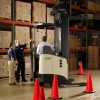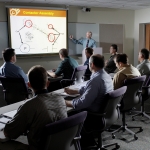
Expanding the Radius of Lift Truck Safety
Ongoing reminders and a dedicated effort to keep important safety information in front of operators and pedestrians help to make safety top-of-mind for employees.
- By Ron Brewer
- Apr 01, 2010
It's no secret executives continue to challenge their companies to reduce costs and increase operational efficiencies. An opportunity worth considering is extending your forklift safety training program beyond just the operator. The benefits can include reduced accidents and injuries, direct cost savings, cost avoidance, and increased productivity.
 The U.S. Department of Labor reports forklift citations are among the most common OSHA violations. For an individual accident, the median number of lost workdays is seven with a direct cost of lost productivity equaling $45,000, according to a calculation by Alert Safety Products based on information from the National Safety Council and the Bureau of Labor Statistics. These figures do not include worker's compensation costs. While the average operator trainer spends only a day or two with new operators, other influencers, such as supervisors and mentors, have a chance to interact with operators on a daily basis and make a long-term difference. There also are opportunities for cost savings with personnel you may not normally consider, such as workplace pedestrians and maintenance staff. Collectively, improved education and understanding among these groups can add up to reduced costs from incidents and increased efficiencies from higher equipment uptime and more productive operators.
The U.S. Department of Labor reports forklift citations are among the most common OSHA violations. For an individual accident, the median number of lost workdays is seven with a direct cost of lost productivity equaling $45,000, according to a calculation by Alert Safety Products based on information from the National Safety Council and the Bureau of Labor Statistics. These figures do not include worker's compensation costs. While the average operator trainer spends only a day or two with new operators, other influencers, such as supervisors and mentors, have a chance to interact with operators on a daily basis and make a long-term difference. There also are opportunities for cost savings with personnel you may not normally consider, such as workplace pedestrians and maintenance staff. Collectively, improved education and understanding among these groups can add up to reduced costs from incidents and increased efficiencies from higher equipment uptime and more productive operators.
Forklift Operators
Forklift operator training is required by law; when done properly, it has proven to be highly beneficial. There are specific areas to consider when deciding how to enhance and improve training for forklift operators.
Properly trained operators finish training with a clear understanding of safe forklift operation. However, without supervisory reinforcement or proper examples set by other operators, they will be less likely to convert that knowledge into safe practice and habit. That conversion is paramount. If it does not occur, the investment in safety training will be less effective.
One tactic to employ to force the conversion/retention process is ongoing reinforcement from trained supervisors. Another tactic is recognizing positive examples from other operators. When evaluating the workplace for best practices, there are some basic questions to ask to determine what type of environment exists for positive and/or negative reinforcement, such as:
- Do your operators feel compelled by their supervisors and co-workers to load or unload a trailer that has a broken dock lock?
- Do they feel punished if they refuse to unload it?
- Do they feel pressured to operate a truck with a non-working horn or with inadequately performing brakes?
- Or, do they feel more valued when they find and report these problems and tag out the equipment until repaired?
Experience shows "rewards" work. And for operators to work as part of your safety program, you need to make sure your workplace rewards are in line with your safety goals to create the best environment for productivity.
Supervisors
Supervisors can be the key asset in controlling operator and pedestrian behavior. It is critical that they be able to distinguish between safe and unsafe operation and employ the right rewards for the environment and situation.
At a minimum, all supervisors should complete forklift safety training. Ideally, they should complete training specifically designed for supervisors of forklift operators. This will enable them to reinforce safe operating habits, develop a culture of safe powered industrial truck use, and reduce the amount of costly retraining.
New technology helps supervisors create a safer environment by leveraging the wealth of information being generated at the truck level. This data organized in a fleet management system allows supervisors to quickly access and understand what’s happening with each truck in the facility. Effective benchmarks and alarms can guide supervisors to make adjustments and fix any problems in order to maximize productivity.
In addition, supervisors should conduct periodic safety meetings with operators and those who work around them. Examples of both safe and unsafe observances during the current period should be discussed along with reminders of safe operating practices and risks for specific tasks (docking, stacking, transporting, etc.) on a rotating basis. Ongoing reminders and a dedicated effort to keep important safety information in front of operators and pedestrians help to make safety top-of-mind for employees.
Workplace Pedestrians
Pedestrians rank near the top of the list of forklift-related accidents and injuries. Employees who work around powered industrial trucks need to be trained on the proper behavior in a material handling work environment. Many pedestrians are injured simply because they are not aware of how forklifts operate.
For example, a common scenario involves pedestrians walking behind a forklift. When the forklift turns, the pedestrian, surprised by the forklift's wide rear swing, gets pinned between the forklift and another object or has his or her foot run over by the forklift’s rear tires.
To avoid injury for this high-risk group, pedestrians should understand forklift dangers and be trained to follow the rules of interaction between forklifts and pedestrians during safety training programs that include visual applications and environmental training. To keep these safe and unsafe practices at the forefront, supervisors should conduct periodic safety meetings with pedestrians.
Supervisors also should know that pedestrian supervision is just as important as forklift operator supervision in maintaining the safe behavior of both parties and avoiding accidents.
Mentors/Lead Operators
Safe, experienced operators with consistently observed safe-operating habits can be a great asset in leading others by example. Many companies reward these operators by identifying them as mentors or lead operators. These mentors can leverage the efforts of supervisors by aiding in coaching, especially of new operators. They can help to ensure new operators practice safe operating habits and are adequately skilled to do their job.
Maintenance Personnel
Adequately trained maintenance personnel are critical to keeping the material handling equipment in safe and reliable operating condition. They must be responsive to items found in need of repair by operators and supervisors, including those discovered during pre-shift inspections or from data gathered by fleet management systems. To maintain forklifts in safe operating condition, they must know not only know how to repair the truck, but also how to keep it performing safely. They should be aware of basic OSHA laws regarding repairs.
Just as important, they must have the proper training to accomplish their jobs in a safe manner. Seek technician training programs that focus on shop safety, control of hazardous energy, and technical training.
Technician training is complex and covers many areas. For this reason, it is important to make sure technician training programs require participants to successfully perform all tasks before they can pass the course.
An effective technician can save the company time and money by keeping the material handling equipment in the best operating form possible.
Operator Trainers
Finally, take note of the qualifications of those conducting the training. Trainers should be expected to do more than simply play a video and set up cones. They should be trained by qualified trainers and use best practices for safe initial hands-on training.
For the most effective training outcomes, operator trainers must understand the forklift in the training, know the laws and standards and be familiar with the workplace. Additionally, they must be an effective trainer themselves by doing some basic things, such as:
- Educating operators on powered industrial truck safety and MHE workplace rules.
- Safely conducting initial hands-on operational training.
- Ensuring that operators develop and practice safe operating habits during hands-on training.
- Supervising step-by-step practice and skill development for all functions/tasks within the operator's responsibility.
Summary
To keep forklift injury costs low and maintain a safe environment, material handling workplace safety is dependent on everyone involved in day-to-day operations. When all parties are trained to understand safe operating practices and their roles in supporting and maintaining those safe practices, all parties and processes benefit. Weak or missing links can jeopardize efforts to maximize safety in the workplace.
While the above examples are the most common influences on safety in the workplace, each business has unique processes, stakeholders, and contributors that require attention. Constant evaluation of your workplace, processes, and people can help identify all areas of opportunity for improvement through training and awareness. Make sure to report progress and any unmet needs to senior management. Keeping them updated on the changes in safety can help them find correlations that can lead to better safety programs.
Don’t get overwhelmed. If necessary, take one step at a time until all potential contributing parties are identified, trained, and advised in their role in contributing to a safe material handling workplace. Each step will produce positive results toward the safest environment for workers and a more productive outcome for the business.
About the Author
Ron Brewer is the manager of Crown Equipment's operator training program. For more information on the company's family of Demonstrated Performance® training solutions and regional training facilities, which includes service, operator, pedestrian, train the trainer, and supervisor training, contact Brewer at 44 S. Washington St., New Bremen, OH 45869, 419-629-2311, 419-629-6334 (fax), or [email protected].